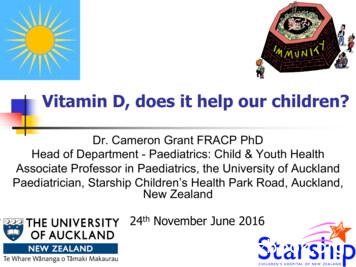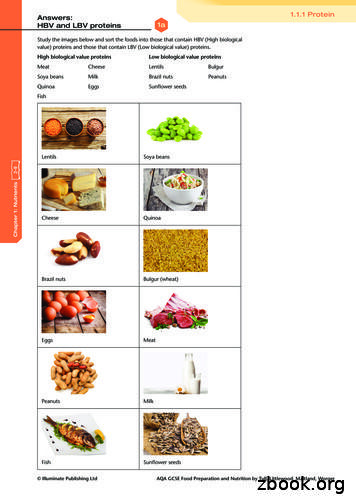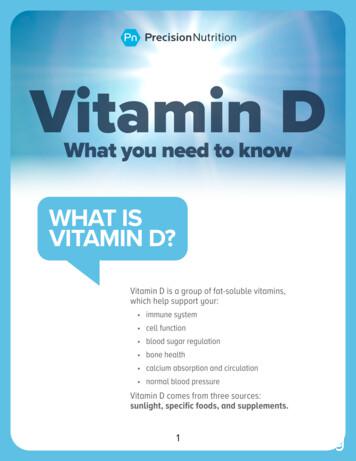Review Article Vitamin D And The Epithelial To Mesenchymal .
Hindawi Publishing CorporationStem Cells InternationalVolume 2016, Article ID 6213872, 11 pageshttp://dx.doi.org/10.1155/2016/6213872Review ArticleVitamin D and the Epithelial to Mesenchymal TransitionMaría Jesús Larriba,1 Antonio García de Herreros,2,3 and Alberto Muñoz11Instituto de Investigaciones Biomédicas “Alberto Sols”, Consejo Superior de Investigaciones Cientı́ficas, Universidad Autónoma deMadrid, IdiPAZ, 28029 Madrid, Spain2Institut Hospital del Mar d’Investigacions Mèdiques, 08003 Barcelona, Spain3Departament de Ciències Experimentals i de la Salut, Universitat Pompeu Fabra, 08003 Barcelona, SpainCorrespondence should be addressed to Marı́a Jesús Larriba; mjlarriba@iib.uam.es and Alberto Muñoz; amunoz@iib.uam.esReceived 4 September 2015; Accepted 8 November 2015Academic Editor: Damian MediciCopyright 2016 Marı́a Jesús Larriba et al. This is an open access article distributed under the Creative Commons AttributionLicense, which permits unrestricted use, distribution, and reproduction in any medium, provided the original work is properlycited.Several studies support reciprocal regulation between the active vitamin D derivative 1𝛼,25-dihydroxyvitamin D3 (1,25(OH)2 D3 )and the epithelial to mesenchymal transition (EMT). Thus, 1,25(OH)2 D3 inhibits EMT via the induction of a variety of targetgenes that encode cell adhesion and polarity proteins responsible for the epithelial phenotype and through the repression of keyEMT inducers. Both direct and indirect regulatory mechanisms mediate these effects. Conversely, certain master EMT inducersinhibit 1,25(OH)2 D3 action by repressing the transcription of 𝑉𝐷𝑅 gene encoding the high affinity vitamin D receptor that mediates1,25(OH)2 D3 effects. Consequently, the balance between the strength of 1,25(OH)2 D3 signaling and the induction of EMT definesthe cellular phenotype in each context. Here we review the current understanding of the genes and mechanisms involved in theinterplay between 1,25(OH)2 D3 and EMT.1. The Vitamin D SystemThe mammalian form of vitamin D is the prohormonevitamin D3 (cholecalciferol), which is obtained from the dietor mainly synthesized in the skin from 7-dehydrocholesterolthrough ultraviolet B radiation. Vitamin D3 is hydroxylated,first in the liver and then in the kidney and other tissues, to generate 1𝛼,25-dihydroxyvitamin D3 (1,25(OH)2 D3 ,calcitriol), the most active vitamin D3 metabolite [1–5].1,25(OH)2 D3 is a major regulator of gene expression andexerts its effects by binding to a transcription factor of thenuclear receptor superfamily: the vitamin D receptor (VDR).VDR heterodimerizes with another member of the samefamily, the retinoid X receptor, and regulates gene expressionin a ligand-dependent manner. The prevailing model holdsthat in the absence of 1,25(OH)2 D3 the heterodimer isbound to specific sequences on its target genes (vitaminD response elements) and to transcriptional corepressorsthat recruit complexes with histone deacetylase activity, thusmaintaining the chromatin in a transcriptionally repressedstate. 1,25(OH)2 D3 induces conformational changes in VDRthat cause the release of corepressors and the binding of coactivators and chromatin remodelers. Together they mediatechromatin opening and permit the entry of the basal RNApolymerase II transcription machinery and transcriptioninitiation [1, 6–9].1,25(OH)2 D3 is a pleiotropic hormone with many regulatory effects. It was classically known for its action on calcium and phosphorus homeostasis and bone mineralization[2, 10]. The seminal discoveries in 1981 that 1,25(OH)2 D3induced myeloid leukemia cell differentiation and inhibited melanoma cell proliferation prompted the interest in1,25(OH)2 D3 as an anticancer agent [11, 12]. Subsequentobservations have shown that 1,25(OH)2 D3 induces differentiation and apoptosis and inhibits proliferation, migration, invasion, and angiogenesis in cancer cells of differentorigin and in several animal models of cancer [1, 5, 13–16]. However, the administration of 1,25(OH)2 D3 to cancerpatients is restricted by its hypercalcemic effects at thetherapeutic doses, enforcing the development of severalanalogs that maintain the antitumoral properties but haveless calcemic actions. Currently, numerous clinical trials
2are ongoing using 1,25(OH)2 D3 or its analogs, alone or incombination with other anticancer agents, against severalneoplasms (https://www.clinicaltrials.gov/) [1, 4, 5, 13].2. Epithelial to Mesenchymal TransitionEpithelial to mesenchymal transition (EMT) is the processby which epithelial cells are converted into mesenchymalcells. It takes place physiologically in several developmentalsituations such as mesoderm formation and neural crestmigration. In the adult, it is reactivated in certain pathologicalconditions such as wound healing, fibrosis, and cancer progression [17, 18]. During EMT, epithelial cells lose cell-cell andcell-extracellular matrix junctions, change from an apicalbasal to a front-rear polarity, reorganize their cytoskeleton,and undergo a gene expression reprogramming characterizedby the downregulation of the epithelial gene signature andthe activation of mesenchymal genes. This process generatesmotile individual cells that can degrade the extracellularmatrix and thus develop a migratory and invasive phenotype[18–21]. EMT is a highly regulated, plastic, and reversibleprocess. Thus, the mesenchymal to epithelial transition(MET) occurs under certain conditions and enables thatmesenchymal cells acquire an epithelial state [22–25].Typical EMT gene reprogramming is mainly orchestrated by key transcription factors including the zinc fingerproteins SNAIL1 and SNAIL2, the double zinc finger andhomeodomain factors ZEB1 and ZEB2, and the membersof the basic-helix-loop-helix family TWIST1 and E47, allknown as EMT transcription factors (EMT-TFs). They arerepressors of E-cadherin (encoded by CDH1), that is themain component of adherens junctions and essential for themaintenance of the epithelial state. Thus, E-cadherin downregulation is considered a hallmark of EMT. In addition to theestablished EMT inducers, other transcription factors such asFOXC2, Goosecoid, KLF8, TCF4 (also known as E2-2), SIX1,HMGA2, Brachyury, and PRRX1 have been recently shownto induce or regulate EMT [18–21, 24]. Expression and/oractivity of the transcription factors that drive EMT is inducedand controlled by several signaling pathways that respondto extracellular cues, with a prominent role for transforminggrowth factor- (TGF-) 𝛽 signaling. The contribution of eachtranscription factor to the EMT depends on the cell or tissuetype involved and the signaling pathway that initiates theEMT. Moreover, EMT-TFs often exhibit reciprocal control oftheir expressions and functional cooperation [18–20, 22, 23].3. 1,25(OH)2 D3 Inhibits EMT3.1. 1,25(OH)2 D3 Induces the Expression of Epithelial Markers.1,25(OH)2 D3 induces epithelial differentiation in several normal and cancer cells. Accordingly, it increases the expressionof components of almost all types of cell adhesion structuresthat are essential for the acquisition and maintenance ofthe epithelial phenotype (Table 1). Remarkably, we foundthat the strong prodifferentiation effect of 1,25(OH)2 D3 inhuman colon cancer cells is associated with an increase in theexpression of the key adhesion molecule E-cadherin. This isaccompanied by the redistribution of 𝛽-catenin from the cellStem Cells Internationalnucleus to the adherens junctions at the plasma membranewhere it interacts with E-cadherin, thus inhibiting the Wnt/𝛽catenin signaling pathway that is aberrantly activated inmost colon tumors and required for colon carcinogenesis[26]. In human colon cancer cells, 1,25(OH)2 D3 also inducesthe expression of the tight junction components occludin,claudin-1, claudin-2, claudin-7, claudin-12, zonula occludens(ZO-) 1 and ZO-2, the desmosomal protein plectin, the focaladhesion members integrin 𝛼3 and paxillin, the constituentof intermediate filaments keratin-13, and proteins associatedwith the actin cytoskeleton such as vinculin, filamin A,and ezrin [26, 27, 29–31, 49, 50]. Interestingly, 1,25(OH)2 D3downregulates cadherin-17 [72], which induces cell proliferation and has protumoral and prometastatic effects in coloncancer cells [73].Treatment of the 𝐴𝑝𝑐min/ colon cancer mouse modelwith 1,25(OH)2 D3 or analogs reduces polyp number andload, while it increases E-cadherin levels and reduces 𝛽catenin nuclear localization and the expression of the 𝛽catenin target genes Tcf1, Myc, and Cd44 in the small intestineand colon [32]. Conversely, 𝑉𝑑𝑟 deficiency in 𝐴𝑝𝑐min/ miceenhances tumor size and the activity of the Wnt/𝛽-cateninpathway in the lesions [65, 74]. Similar results were observedin other mouse and rat models of colon dysplasia, coloncancer, and colitis-associated neoplasia when treated withvitamin D3 or 1,25(OH)2 D3 analogs [33, 63, 64]. Moreover,1,25(OH)2 D3 increases and restores the normal level of Zo1, occludin, and claudin-1 proteins in the colonic epitheliumof the dextran sulfate sodium- (DSS-) induced colitis mousemodel, protecting mice from intestinal mucosa injury andepithelial barrier disruption [27]. Conversely, 𝑉𝑑𝑟 deficiencypotentiates DSS effects in this model, as DSS-treated 𝑉𝑑𝑟 / mice have severely disrupted and opened tight junctions anddesmosomes in the colonic epithelium and develop moresevere colitis than wild-type animals [29]. These data indicatethat 1,25(OH)2 D3 contributes to the homeostasis and healingcapacity of the colonic epithelium by preserving the stabilityand structural integrity of tight junctions [75]. Remarkably,a randomized, double-blind, placebo-controlled clinical trialshowed that daily treatment of colorectal adenoma patientswith 800 IU of vitamin D3 for 6 months increases E-cadherinexpression in normal-appearing rectal mucosa [34, 76].In addition to colon cancer, E-cadherin is induced by1,25(OH)2 D3 or analogs in normal mammary and bronchialepithelial cells and in tumor cell lines derived from breast,prostate, non-small cell lung, and squamous cell carcinomas,usually associated with an increase in epithelial differentiation, a reduction in cell migration and invasion, andthe inhibition of Wnt/𝛽-catenin signaling [35–41, 61, 77,78]. We have described that the mechanism of E-cadherininduction by 1,25(OH)2 D3 in human colon cancer cells istranscriptional indirect and requires the transient activationof the RhoA-ROCK-p38MAPK-MSK1 signaling pathway [26,31]. Phosphatidylinositol 5-phosphate 4-kinase type II 𝛽 isalso needed for E-cadherin induction by 1,25(OH)2 D3 incolon cancer cells [79]. In agreement with the transcriptionalregulation, Lopes et al. showed that 1,25(OH)2 D3 treatmentcauses partial demethylation of CpG sites of CDH1 promoterin MDA-MB-231 triple-negative breast cancer cells [78].
Stem Cells International3Table 1: List of 1,25(OH)2 D3 -regulated proteins involved in EMT.Protein1,25(OH)2 D3 effectTight junction erens junction cal adhesion membersIntegrin 𝛼3UpregulationUpregulationIntegrin 𝛼VIntegrin 𝛽5UpregulationDownregulationIntegrin 𝛼6DownregulationIntegrin on-related proteinsFilamin tinUpregulationExtracellular matrix proteinsFibronectinDownregulationCollagen type IDownregulationCollagen type IIDownregulationCollagen type IIIDownregulationMMPs and DownregulationTWIST1DownregulationWnt/𝛽-catenin target gulationCyclin D1DownregulationReference[26–28][27, 29][29, 30][31][30][26, 27, 29][26][26, 29, 31–46][37, 41, 42, 47, 48][37][26, 31][31][37][37][37][37][31, 37][37][49][50][37, 43–46, 51–54][49][40–42][49][44, 45, 51, 54][44, 45, 51, 53–57][56][44, 51, 54, 58][39, 41, 42][39, 41, 42, 59, 60][48, 61][59, 60][59][40–42, 44, 61, 62][42, 61, 62][40][61][26, 32, 63, 64][26, 32][26, 32][31, 33, 55, 64]Table 1: Continued.Protein1,25(OH)2 D3 effectAXIN2DownregulationLEF1DownregulationOther EMT-related proteinsJMJD3UpregulationCystatin DUpregulationCathepsin TGF-𝛽 receptor type 65][65][66][67][68][69][70][71][44, 54, 56, 58][44][72]Moreover, protein kinase C inhibitors block E-cadherin, Pcadherin, 𝛼-catenin, and vinculin translocation to cell-cellcontacts and the assembly of adherens junctions promotedby 1,25(OH)2 D3 in cultured human keratinocytes [80].We reported that 1,25(OH)2 D3 induces cell adhesion,inhibits cell migration and invasion, and profoundly affectsthe phenotype of human breast cancer cells [37]. It promotesthe formation of focal adhesions by increasing the expressionof integrin 𝛼V , integrin 𝛽5 , paxillin, and focal adhesion kinase(FAK) proteins and also by inducing FAK phosphorylation.Additionally, 1,25(OH)2 D3 reduces the expression of the mesenchymal marker N-cadherin and the myoepithelial proteinsP-cadherin, integrin 𝛼6 , integrin 𝛽4 , and 𝛼-smooth muscleactin (𝛼-SMA). Thus, 1,25(OH)2 D3 reverts the myoepithelialfeatures that are associated with more aggressive and lethalforms of human breast cancer [37]. Likewise, N-cadherinexpression is strongly suppressed by 1,25(OH)2 D3 in mouseosteoblast-like cells [47]. In line with these data, 1,25(OH)2 D3treatment blocks the EMT-associated cadherin switch (fromE-cadherin to N-cadherin) in pancreatic cancer cells [42].Notably, 1,25(OH)2 D3 enhances corneal epithelial barrierfunction as corneal epithelial cells treated with 1,25(OH)2 D3show increased occludin levels, reduced permeability, andelevated transepithelial resistance, a measure of the functional integrity of tight junctions [28].3.2. 1,25(OH)2 D3 Inhibits the Expression of EMT-TFs. Weand others have reported that 1,25(OH)2 D3 regulates theexpression of certain transcription factors that induce EMTand of several modulatorsof the epithelial phenotype that can influence the expression of the EMT inducers (Table 1). 1,25(OH)2 D3increases by a transcriptional indirect mechanism the expression of Jumonji Domain Containing 3 (JMJD3), a histoneH3 lysine 27 demethylase with putative tumor suppressoractivity. JMJD3 mediates the induction of a highly adhesiveepithelial phenotype, the antiproliferative effect, the generegulatory action, and the antagonism of the Wnt/𝛽-cateninpathway promoted by 1,25(OH)2 D3 in human colon cancercells [66]. Moreover, JMJD3 depletion upregulates SNAIL1,ZEB1, and ZEB2, increases the expression of the mesenchymal markers fibronectin and LEF1, and downregulates
4the epithelial proteins E-cadherin, claudin-1, and claudin-7.Accordingly, JMJD3 and SNAIL1 RNA expression correlateinversely in samples from human colon cancer patients [66].The induction of ZEB1 by JMJD3 depletion is associatedwith the downregulation of miR-200b and miR-200c, twomicroRNAs that target ZEB1 RNA and inhibit ZEB1 proteinexpression [81].1,25(OH)2 D3 directly induces the expression of cystatinD, an inhibitor of cysteine proteases of the cathepsin family encoded by CST5 gene. The binding of VDR to theCST5 promoter induced by 1,25(OH)2 D3 is accompaniedby the release of the NCOR2 corepressor and an increasein histone H4 acetylation [67]. We found that cystatin Dmediates the antiproliferative and prodifferentiation actionof 1,25(OH)2 D3 in human colon cancer cells. In addition,ectopic cystatin D expression inhibits proliferation, migration, anchorage-independent growth, and the Wnt/𝛽-cateninpathway in cultured colon cancer cells and reduces tumordevelopment in xenografted mice [67]. Cystatin D repressesSNAIL1, SNAIL2, ZEB1, and ZEB2, whereas it induces theexpression of E-cadherin and other adhesion proteins suchas occludin and p120-catenin. Accordingly, cystatin D andE-cadherin protein expression directly correlate in humancolorectal cancer, and loss of cystatin D is associated withpoor tumor differentiation [67]. Notably, transcriptomic andproteomic studies comparing cystatin D-overexpressing andmock-transfected human colon cancer cells indicated that“cell adhesion, cell junction, and cytoskeleton” is one ofthe gene categories that englobes more cystatin D-regulatedgenes and proteins [82]. Remarkably, Swami et al. showedthat the expression of cathepsin L, whose activity is inhibitedby cystatin D, is downregulated by 1,25(OH)2 D3 in breastcancer cells [68], while Zhang et al. described that silencingof cathepsin L suppresses the cell invasion and migration, theactin cytoskeleton remodeling, and the increase in SNAIL1expression associated with TGF-𝛽-promoted EMT in breastand lung cancer cells [83].1,25(OH)2 D3 reduces the expression of Sprouty-2, an intracellular modulator of growth factor tyrosine kinase receptorsignaling involved in the regulation of cell growth, migration, and angiogenesis [69]. Sprouty-2 strongly inhibits theinduction of intercellular adhesion and E-cadherin proteinexpression promoted by 1,25(OH)2 D3 , and gain- and loss-offunction experiments indicate that Sprouty-2 and E-cadherinrepress each other in colon cancer cells. Accordingly, theprotein expression levels of Sprouty-2 and E-cadherin correlate inversely in cultured and xenografted colon cancer cellsand in biopsies from human colon cancer patients. In linewith this, we found that Sprouty-2 induces ZEB1 expressionwithout affecting ZEB2, SNAIL1, or SNAIL2 levels [69]. ZEB1upregulation by Sprouty-2 results from the induction ofthe transcription factor ETS1 and the repression of severalmicroRNAs (miR-200 family and miR-150) that target ZEB1RNA. Through ZEB1 upregulation, Sprouty-2 represses Ecadherin, claudin-7, occludin, the tight junction modulatormatriptase, the cell adhesion molecule EPCAM, and theepithelial splicing regulatory protein ESRP1 that inhibits EMT[84]. Taken together, these data point to Sprouty-2 as a potentinhibitor of the epithelial phenotype that is downregulated by1,25(OH)2 D3 in colon carcinoma cells.Stem Cells InternationalRecently, effects of 1,25(OH)2 D3 on the expression ofseveral EMT-TFs have been described. 1,25(OH)2 D3 inhibitsSNAIL1 and ZEB1 expression in non-small cell lung carcinoma cells, accompanied by an increase in E-cadherin expression, vimentin downregulation, maintenance of the epithelialmorphology, and inhibition of cell migration [40]. The lowcalcemic 1,25(OH)2 D3 analog MART-10 inhibits EMT andcell migration and invasion in breast and pancreatic cancercells through the downregulation of SNAIL1 and SNAIL2.In addition, MART-10 inhibits TWIST1 expression in breastcancer cells [42, 61]. Accordingly, Findlay et al. reported theinhibition of SNAIL1 and SNAIL2 by 1,25(OH)2 D3 in humancolon cancer cells [62]. Kaler et al. found that colon cancer cells stimulate tumor-associated macrophages to secreteinterleukin- (IL-) 1𝛽, which in turn promotes Wnt/𝛽-cateninsignaling, stabilizes SNAIL1 protein, and confers resistance toTRAIL-induced apoptosis in colon cancer cells [71]. They alsofound that 1,25(OH)2 D3 , by inhibiting the release of IL-1𝛽by macrophages, downregulates SNAIL1 protein expressionin colon cancer cells [71]. Similarly, Zhang et al. showed thattumor-associated macrophages induce EMT in breast cancercells and that high VDR expression in cancer cells abrogatesthe macrophage-promoted E-cadherin loss, 𝛼-SMA upregulation, and increase in cell migration and invasion [43].Furthermore, 1,25(OH)2 D3 attenuates the enhancing effectof TGF-𝛽1 on cell motility and on SNAIL1, N-cadherin, andvimentin expression in human bronchial epit
process. us, the mesenchymal to epithelial transition (MET) occurs under certain conditions and enables that mesenchymal cells acquire an epithelial state [ ]. Typical EMT gene reprogramming is mainly orches-trated by key transcription factors including the zinc nger proteins SNAIL
Konsumsi asam folat, vitamin B12 dan vitamin C pada ibu hamil tergolong masih rendah, sehingga konsumsi sumber vitamin perlu ditingkatkan untuk mencegah masalah selama kehamilan, seperti anemia, prematur, dan kematian ibu dan anak. Kata kunci: asam folat, ibu hamil, vitamin B12, vitamin C *Korespondensi: Telp: 628129192259, Surel: hardinsyah2010@gmail.com J. Gizi Pangan, Volume 12, Nomor 1 .
Milk Thistle Red Clover Rhodiola St. John’s Wort Soy Bean Tomato Tribulus Terrestris Willow Vitamin B1 Vitamin B2 Vitamin B6 Vitamin B12 Vitamin C Vitamin D3 Vitamin E MISCELLANEOUS Alpha Lipoic Acid Beta Carotene Caffeine Choline Bitartrate Chond. Sulphate Bovine Chond. Sulphate Porcine Ch
Normal vitamin D 36% 9% 55% Vitamin D deficiency* Severe vitamin D deficiency** Normal vitamin D Camargo CA, Jr., Ingham T, Wickens K, et al. Vitamin D status of newborns in New Zealand. Br J Nutr 2010;104:1051 -7. Grant CC, Wall CR, Crengle S, Scragg R. Vitamin D deficiency in early childhood Public Health Nutr. 2009;12(10):1893-1901
Amendments to the Louisiana Constitution of 1974 Article I Article II Article III Article IV Article V Article VI Article VII Article VIII Article IX Article X Article XI Article XII Article XIII Article XIV Article I: Declaration of Rights Election Ballot # Author Bill/Act # Amendment Sec. Votes for % For Votes Against %
VITAMIN A This vitamin helps your body maintain healthy eyes and skin. VITAMIN C This vitamin helps the body heal cuts and wounds and maintain healthy gums. VITAMIN E This vitamin helps maintain healthy cells throughout your body. WATER Water makes up more than half of your body weight. Your
Vitamin A Keeps the skin healthy Helps us see in dim light Helps children to grow Keeps mucous membranes moist and healthy This vitamin is an antioxidant Vitamin D Helps calcium to be absorbed in the body Helps calcium to strengthen the bones and teeth Vitamin E This vitamin is an antioxidant Vitamin K Helps the blood.
25-OH Vitamin D levels* To determine vitamin D status * Only measure if patient is symptomatic and has risk factors for Vitamin D deficiency. Measurement, status and management (see Appendix 1 for flowchart) Vitamin D level Vitamin D status Health effect Management 30 nmol/L Defi
important.1 But the form of the vitamin D in it is. Look for supplements that contain: Vitamin D3, which is superior at optimizing and maintaining vitamin D levels long-term2 3 Or, if you prefer a plant-based option: Vitamin D2, which is derived from yeast or mushrooms For best absorption, take vitamin D with a meal, especially one that .























